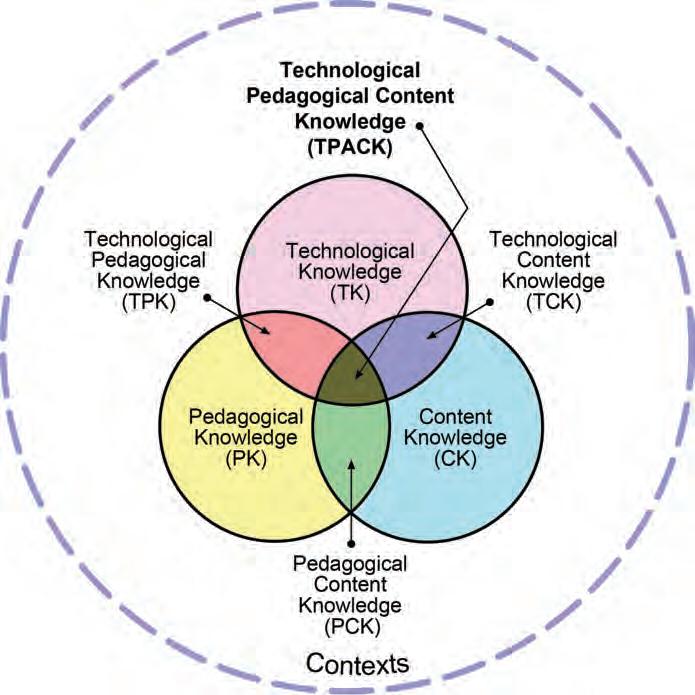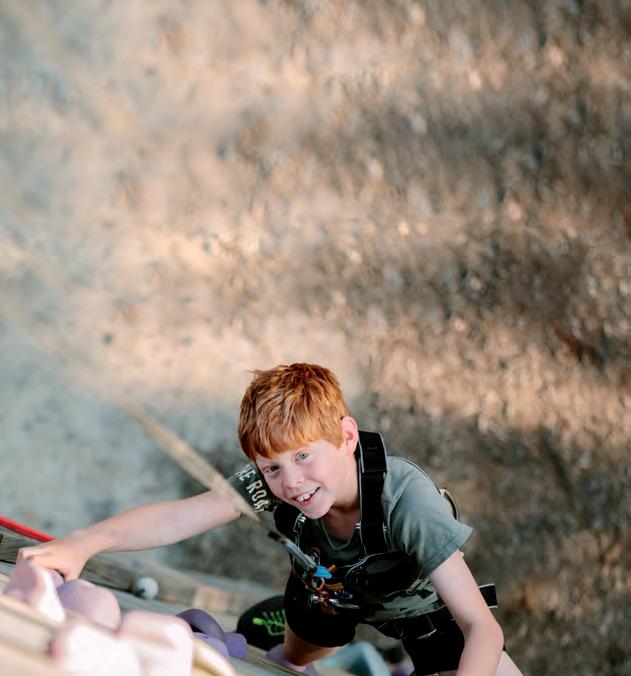
9 minute read
One size doesn’t fit all
ACCORDING TO DR MICHAEL PHILLIPS OF MONASH UNIVERSITY, THERE IS NO ONE-SIZE-FITSALL APPROACH TO TECHNOLOGY FOR THE CLASSROOM. INSTEAD, HE SAYS, IT’S IMPORTANT FOR EDUCATORS TO UNDERSTAND HOW THE TECHNOLOGY WORKS AND WHETHER OR NOT IT’S THE RIGHT FIT FOR THEIR PARTICULAR CLASSROOM.
As educators, we are often exposed to advertisements promoting the use of digital technologies in our classrooms. Additionally, pressures from state and federal curriculum documents and even from school leaders and parents can make teachers feel as though they have to constantly be using the latest hardware and software.
While there are undoubtedly a range of ‘stateof-the-art’ examples in which teaching and learning are enhanced through the use of educational technologies, the ‘state-of-the-actual’ in many classrooms is quite different. Many educators struggle to keep up with the latest technological developments and to consider the ways these might best work for the students they are teaching.
Dr Michael Phillips is a Senior Lecturer in the Faculty of Education at Monash University. His work focuses on the knowledge expert teachers develop when integrating educational technologies into their practice. Additionally, Dr Phillips researches the ways in which expert teachers make active decisions about their classroom technology integration. His research regularly involves collaboration with colleagues from Australia, the United States, Europe, Asia and the sub-continent.

The TPACK framework suggests that the most effective educational technology integration occurs when technological, pedagogical and content knowledge overlap. Photo credit: The TPACK framework, reproduced by permission of the publisher, © 2012 by tpack.org.
While there are undoubtedly a range of ‘state-ofthe-art’ examples in which teaching and learning are enhanced through the use of educational technologies, the ‘state-of-the-actual’ in many classrooms is quite different. Many educators struggle to keep up with the latest technological developments and to consider the ways these might best work for the students they are teaching.
TEACHING IS A PEOPLE BUSINESS All of the great teachers I have met share one thing in common. They love working with people. At its core, I believe teaching is a people business. If you cannot relate to the students in front of you, it is going to be very difficult to understand what may or may not resonate with them. Not understanding what motivates, engages and frightens the students in your classroom means that you are likely to miss the mark more often than you hit it. So, trying to work out what technologies might work as part of your teaching practice has to start with the students you are teaching.
With the latest app, there may be great opportunities that others rave about, but if this isn’t going to resonate with your students, then it is unlikely to have similar results for you.
The first thing to consider is your pedagogical knowledge – understanding the relationship between your teaching and your students’ learning. At the heart of this relationship is people and not all technologies are going to work in the same way with different groups of people (or even with the same group of people at different points in time).
CONTENT IS A BIG DEAL The particular information that you are presenting to your students makes a really big difference. Unlike secondary school teachers, primary teachers so often need to be familiar with a huge variety of content. The way that content is organised reveals a great deal about the nature of the knowledge being taught. Even if we take what appears to be one subject – like Science – we can find really important differences between Biology and Chemistry, for example.
Biologists like to think in terms of systems and how these interact with one another. Chemists like to break down more complex structures into their constituent parts. This means the way information gets represented looks very different for these topic areas and one thing that digital technologies are able to do really well is represent information in a variety of ways. Thinking deeply about your content knowledge allows you to carefully consider what digital technologies will allow you to best represent different types of information – this is not a one-size-fits-all model.
GETTING DOWN TO THE TECHNOLOGICAL BIT Many teachers I have worked with start with considerations of the technology – “What button do I need to press to make it…?” is the kind of question many teachers ask. While the technical aspects of some technologies can make things challenging, many of the really well designed, newer forms of technology are powerful but also user friendly.
Instead of worrying about which buttons you are going to need to know about, I encourage educators to think about a deeper form of technological knowledge as well. The form of technological knowledge that my research has shown to be really important is understanding the connections between technological opportunities and constraints, and your pedagogical and content knowledge.
Asking: In what ways does this technology allow me to better represent particular content to my particular students at this particular point in time for a very particular purpose lies at the heart of effective technology integration.
An easy way to picture this is in the TPACK framework diagram in which technological, pedagogical and content knowledge are represented as overlapping circles. Punya Mishra and Matt Koehler who developed this model argue that the most effective educational technology integration occurs at the nexus of these three circles – when our Technological, Pedagogical And Content Knowledge (or TPACK for short) all come together in our own particular context. EM
Inspiring adventure camps
Bring learning to life with exciting, action-packed adventure activities at three beautiful locations: ◾ Camp Rumbug
Near Wilsons Prom, Victoria ◾ Campaspe Downs
Near Hanging Rock, Victoria ◾ Kindilan
Redland Bay, Queensland
✓ Adventure activities ✓ Free evening entertainment

✓ Full board accommodation ✓ Dedicated PGL Groupie
FREE morning & afternoon tea. Quote EMS0619 when you book.
Find out more at www.pgladventurecamps.com.au
Confidence is key
LIFELONG LEARNING STARTS WITH CONFIDENCE AND HANDS-ON LESSONS SUPPORT STUDENT SUCCESS, ACCORDING TO THE RESULTS OF A RECENT GLOBAL SURVEY COMMISSIONED BY LEGO EDUCATION WHICH AIMS TO PROVIDE INSIGHT ON HOW CHILDREN ARE LEARNING IN THE 21ST CENTURY.
The Hopper Race lesson enables students to design prototypes to determine the most effective way to move a robot without using wheels.

More than half of students also said that handson learning made them more confident in Science, Technology, Engineering, Arts and Mathematics (STEAM). Students who are confident in learning STEAM subjects are two times more likely to say they are confident at school.
The Confidence in Learning Poll, fielded by Harris Insights & Analytics, was conducted online from 6 to 28 February 2019, with findings released in early April. A total of 5002 students, 5001 parents and 1152 teachers from around the world took part in the research.
Each of the parties agreed that hands-on learning was highly beneficial to learning; with 99 per cent of teachers stating that they believe handson learning builds student confidence, 89 per cent of students saying hands-on learning helps them remember topics longer, and 93 per cent of parents saying they believe hands-on learning helps children retain knowledge for the future.
In addition, more than half of students also said that hands-on learning made them more confident in Science, Technology, Engineering, Arts and Mathematics (STEAM). Students who are confident in learning STEAM subjects are two times more
Hands-on projects can assist students to build confidence in STEAM.
likely to say they are confident at school. However, less than one fifth of students surveyed say they are “very confident” in learning STEAM subjects.
Modern Teaching Aids, thought leaders in the digital technology space agree that the best way to build confidence in STEAM is to enable students to work on a hands-on project with others.
Understanding the important role hands-on learning plays in the modern classroom, LEGO Education has developed SPIKE Prime, the newest product to join its STEAM learning portfolio.
“The Confidence Poll data shows that most students say if they failed at something once, they don’t want to try again. With SPIKE Prime and the lessons featured in the SPIKE app, these children will be inspired to experiment with different solutions, try new things and ultimately become more confident learners. And for teachers, time is the ultimate barrier.”

LEGO Education produces hands-on, crosscurricular STEAM solutions for early learning, primary and secondary education, competitions and afterschool programs.
Designed as a learning tool for students in Years 5-8, LEGO Education’s SPIKE Prime combines colourful LEGO building elements, easy-to-use hardware and intuitive drag-and-drop coding language based on the Scratch Coding Platform.
Through engaging students in playful learning, SPIKE Prime was specifically designed to encourage students to think critically and solve complex problems, regardless of their learning level.
From easy-entry projects to limitless creative design possibilities, SPIKE Prime uses fun ways to assist students to learn the essential STEAM and 21st century skills needed to become the innovative minds of tomorrow.
SPIKE Prime offers four unit plans, each with a specific theme and focus. All units are designed to develop critical thinking skills through complex,

engaging and personally relevant STEAM challenges. Each unit focuses on a specific STEAM strand, whether this is engineering, technology, mathematics or competitions. It is powered by the SPIKE app and includes lessons that are designed to be completed within a 45-minute class. This also includes teacher support, introduction videos, links to curriculum standards, hints, extension ideas, assessment tools and technical support to help create confident teachers from the moment they open the box.
Each SPIKE Prime set has 523 pieces which can be used to build many different creations including corresponding STEAM lesson plans that were created by and for educators to help them bring more hands-on STEAM learning into their curriculum and get students more engaged and excited about STEAM subjects.
LEGO Education and the LEGO Group have also created 11 new innovative elements, which have been debuted with SPIKE Prime. These new elements include an innovative integrator brick, which allows for
89 per cent of students surveyed said hands-on learning assisted them to remember topics longer.
building together with both the LEGO Technic and the LEGO system platforms, further expanding systematic creativity and the building possibilities.
As well as bringing STEAM creativity and engagement into the classroom, SPIKE Prime also brings this into robotics clubs, coding programs and maker spaces.
The SPIKE Prime Expansion set in combination with the Competition Ready Unit – one of the four units included in the software, will prepare both teachers and students for robotics competitions. It can help empower students and teachers who are new t o robotics and in need of more formalised training.
SPIKE Prime will be available to pre-order from Modern Teaching Aids from 4 June 2019. EM
Buyer’s Guide Modern Teaching Aids Ph: 1800 251 497 Web: www.teaching.com.au








